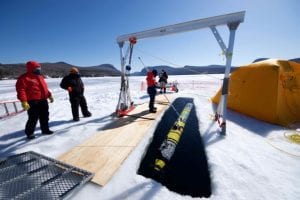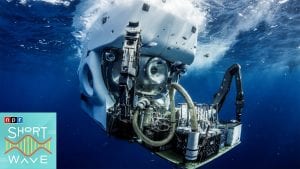WHOI in the News
Why Are Scientists Studying Coral’s Smell?
All living things release volatile chemicals, and many species have adopted specific volatiles as communicative signals. Scientists have long studied their function in terrestrial organisms.
Ropeless fishing tech could help save rare whale, say scientists
Virtual buoys and time triggered traps reduce risk to endangered North Atlantic right whale, but reactions among fishers in US and Canada are mixed.
Endangered North Atlantic Right Whales Experience Highest Birth Rate Since 2015
Endangered North Atlantic right whales gave birth in greater numbers this winter compared to the past six years — a promising sign for a species that’s been driven to the brink of extinction due to human activity.
Ancient atmospheric oxygen sleuthing with ocean chromium
Currently, geoscientists and paleoceanographers from MIT and the Woods Hole Oceanographic Institution (WHOI) are looking to add another use to that list: as a way to examine chemical shifts in ancient Earth’s oceans and atmosphere that are preserved in the seafloor’s paleorecord.
Alvin Pilot Is Guest Speaker For Supper Club Series
Warmer World Needs More Protected Habitat
With climate change soon to be the main threat to biodiversity, protected habitat will be a higher priority than ever to give wildlife a chance.
Deep-sea exploration breakthrough to guide future space exploration missions
The ASU researchers exploring deep sea hydrothermal vents as part of the SUBSEA project moved their modeling to the beginning of this process, significantly speeding up their ability to interpret the data from months to a couple of hours.
Cape Cod Researchers To Test New Camera That Could Protect Right Whales From Ships
The technology is a miniaturized version of a system originally designed to protect whales from underwater noises.
Arctic scientists test underwater drone on Willoughby Lake
New England winters can often feel as cold as the Arctic. But for researchers from WHOI’s Applied Ocean Physics & Engineering department, Vermont’s polar-like cold proved to be the perfect testing site for Remus 600. The state’s deepest lake – Lake Willoughby – offered fewer risks than the Arctic Ocean, while providing important data about ice measurement and water temperature, helping to streamline the real mission this fall.
We’ve Known For Years Global Warming Could Lead To A New Ice Age. Why Is No One Doing Anything?
The possibility that climate change could flip and, in just a matter of years, plunge part of the world into a new ice age is something that has occasionally made its way into the media.
Slowdown of powerful current system could negatively impact climate patterns, study says
A new study says the powerful system of currents that are the flywheel of Earth’s climate might be weakening. WHOI president and director Peter de Menocal joined Elaine Quijano on CBSN with details.
The Broadcast with Jane Adey
The ocean is a part of daily life in Newfoundland and Labrador. Whether it’s fishing, tourism, shipping, research or culture, there are thousands of people whose lives have some connection to the sea. The Broadcast casts a wide net to explore the stories of people in coastal communities in Newfoundland and Labrador and around the world.
Climate change can destabilize the global soil carbon reservoir, new study finds
“The study results indicate that at the large ecosystem scale of river basins, soil carbon is sensitive to climate variability.”
WHOI Study Finds Offshore Pile Driving Noise Alters Feeding Behaviors of Longfin Squid
Study Finds That Offshore Pile Driving Noise Alters Feeding Behaviors Of Longfin Squid
With the offshore wind industry expanding in the United States and elsewhere, a new study raises questions about how the noise from impact pile driving to install turbine supports can affect feeding behaviors of longfin squid, a commercially and ecologically important cephalopod.
The Gulf Stream Is Weakening and It Promises Stronger Storms For NY And NJ
The oceanic network matters because it has an outsized influence on making the world habitable, said Peter de Menocal, the president and director at Woods Hole Oceanographic Institution.
A Gruesome Feeding Frenzy in the Atlantic Ocean
Even when a whale dies an unnatural death, its body joins the ocean’s vast circle of life. And very often, that circle is very messy, and it involves sharks. WHOI’s Dr. Michael Moore speaks with The Atlantic about a feeding frenzy in the Atlantic Ocean.
First description of deep benthic habitats and communities of oceanic islands and seamounts of the Nazca Desventuradas Marine Park, Chile
A Quick Dive Into How Submarines Work
Submarines can descend thousands of feet below the surface of the ocean, but to do so, they have to deal with an enormous amount of pressure. NPR caught up with WHOI’s Bruce Strickrott, Group Manager and Chief Pilot of the Deep Submergence Vehicle Alvin, who explains some of the fundamental engineering principles that allow submarines to dive so deep without imploding under the pressure, and shares updates on Alvin’s overhaul and future dives.
Human Occupied Vehicle (HOV) Alvin is part of the National Deep Submergence Facility (NDSF). Alvin is one of the most recognized deep submergence vessels in the world and the only one in the U.S. capable of carrying humans into extreme ocean depths. The sub has completed 5,065 successful dives, more than all other submersible programs worldwide combined. When Alvin relaunches next fall, the iconic sub will have the ability to dive to 6500 meters (21,325 feet)—almost 4 miles deep and 2,000 meters deeper than Alvin’s current maximum depth of 4500 meters (14,800 feet). The upgrade will also give the sub access to 99% of the ocean floor.
Deep Sea Science: Deep Sea Reveals Insights On Human
Scientists have discovered bacteria from the deep sea with components that are unrecognizable by the human immune system and may hold important properties in the development of cancer treatments and vaccines, according to a collaborative study published in Science Immunology.
UAF’s Seward Marine Center celebrates a half-century of supporting marine research
Street Name Change Coming To WHOI Campus
According to WHOI, the Falmouth planning board approved the name change of a street that winds through its campus…from Maury Lane to Marie Tharp Lane.
When ‘Eradicated’ Species Bounce Back With A Vengeance
Some invasive species targeted for total eradication bounce back with a vengeance.



